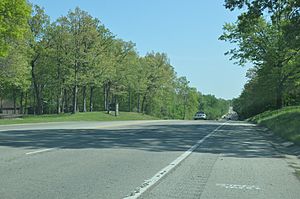Carpenter Park facts for kids
Carpenter Park is a large park in Springfield, Illinois. It covers about 322 acres (1.3 square kilometers) of land. The park is located on the north side of Springfield, right next to the Sangamon River.
A special part of Carpenter Park is an Illinois Nature Preserve. This means it's a protected area because of its natural beauty and wildlife. It's also known as an Important Bird Area of Illinois because many different kinds of birds live there. The Springfield Park District manages the park. It's even a cool stop along the historic old Route 66!
Contents
Park History
Early Times and Native Americans
Long ago, the area that is now Carpenter Park was a thick forest. It stood out from the wide, grassy prairie that covered most of central Illinois. Native American tribes used the Sangamon River as a travel path for their canoes. They often camped in this forest because it had plenty of wood for fires.
During the War of 1812, some Native American groups fought against the settlers in the Illinois Territory. They wanted to protect their way of life. After the war, settlers gained control of central Illinois. This opened the land for fur trading and new settlements.
The Carpenter Family
Because it was a nice wooded area, the land quickly found a new owner. A man named William Carpenter took control of the land in 1838.
The Carpenter family used the forest in ways common for that time. William Carpenter started a small ferry to cross the Sangamon River. He also built a mill that used the river's power. This mill cut wood from local trees and ground corn into cornmeal. The ferry was near where a bridge for U.S. Route 66 was later built. A new bridge stands there today.
The Carpenter family owned the land until 1922. That year, William's daughter, Sarah Carpenter, sold it to the Springfield Park District. They paid $87,310 for the property. The land was then named Carpenter Park. A few years later, in 1926, U.S. Route 66 was created. It included a road next to the park, now called Peoria Road.
Carpenter Park Today
Forests and Trees
After being used a lot in the early 1800s, the forests in Carpenter Park have grown back. They are now so healthy that they are listed as a State Natural Area. The park has two main types of forests. One is a wet-mesic forest, found in the Sangamon River floodplain. The other is a dry-mesic upland forest, which sits on a low sandstone bluff.
In the dry-mesic upland forest, you'll find many white oak trees. The white oak is the state tree of Illinois! You'll also see its relatives, the black oak and bur oak. Other trees include black walnut, black cherry, and hickory trees. In some areas, you might spot pawpaw and sassafras trees growing. This older forest provides lots of nuts and seeds, called mast. This food helps feed animals like whitetail deer and other wildlife.
Closer to the Sangamon River, the wet-mesic forest has large, old sycamore trees. You'll also find silver maple, cottonwood, and boxelder trees. In the sloped areas between the two forest types, red oak trees grow.
Wildlife and Recognition
The park's forest is old and has many different kinds of plants and animals. People have seen 82 different types of birds here! Because of its importance, the park was named an Illinois Natural Area in May 1979.
Old U.S. Route 66 still runs next to the park. Carpenter Park has a picnic area for people traveling along this famous historic road. In 2007, Carpenter Park was also named an Important Bird Area of Illinois.
The Park Tomorrow
The Springfield Park District has a plan for Carpenter Park's future. This plan, made in 2008, focuses on protecting the natural area. It suggests using controlled burns. These are small, planned fires that help certain trees, like bur oaks, grow and reproduce.
The park district also hopes to build a better trail along the Sangamon River's sandstone bluffs. These bluffs are slowly crumbling due to erosion. The new trail would have a railing to make it safer and easier to enjoy the views.


